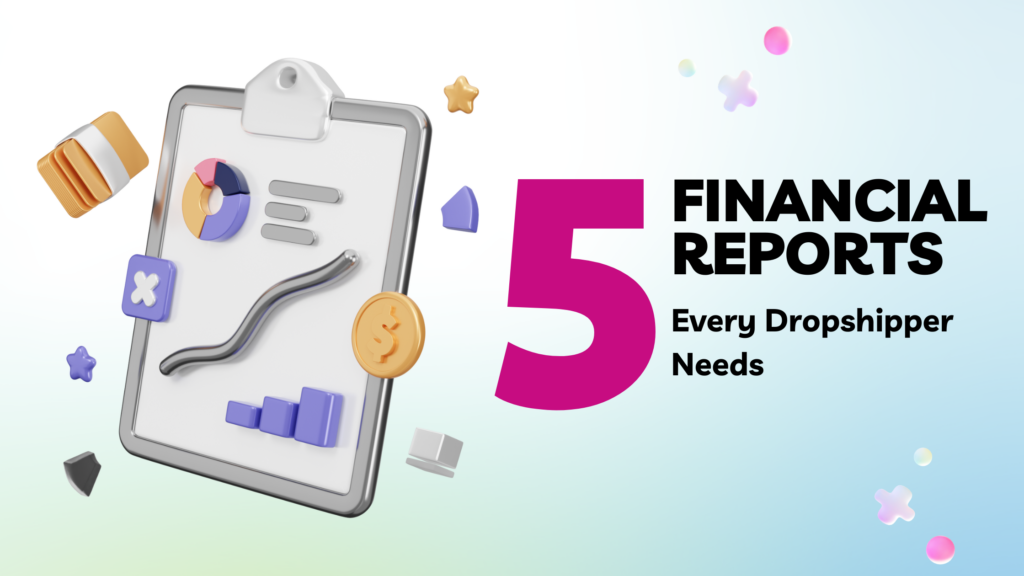5 Financial Reports Every Dropshipper Needs
Staying ahead in e-commerce means fully understanding your numbers. Good money health depends on clear insights from your earnings, costs, and balance sheets.
This guide gives you the basics to manage your finances better, whether you’re tightening things up or getting ready to grow.
Get ready to explore the straightforward tactics that will fine-tune your money skills and boost your dropshipping business.
1. Revenue Reports: The Sales Pulse of Your Dropshipping Business
Keeping a close watch on revenue reports is crucial for the health of your dropshipping business.
They are detailed records that show whether you’re making money and how much.
By understanding these reports, you can see where your business stands and what you need to do to improve.
Understanding the Core Revenue Streams in Dropshipping
Knowing where your money comes from is the first step.
Product sales are your primary source of income; this is the amount customers pay for the items you sell.
Then there’s revenue from shipping and handling charges, which might seem minor, but they add up over time and contribute significantly to your business.
However, it’s not just about the money coming in.
You must also keep track of returns, refunds, and cancellations.
These can decrease your profits if they happen too often.
Pay attention to these numbers to ensure they don’t get out of hand.
Don’t forget about the money you can make through other channels, like affiliate marketing and advertising. If you promote other companies’ products or host ads on your website, these can provide additional income streams that bolster your business.
Creating Effective Revenue Reporting Dashboards
A revenue reporting dashboard is a tool that displays your financial data through charts and graphs, making it easier to understand your business’s performance.
When setting up your dashboard, select metrics that make sense for dropshipping, such as sales growth, conversion rates, and customer lifetime value (LTV).
These metrics give you a clearer picture of how well your business is doing and where you can improve.
To save time, use software that can automatically gather data and update your dashboard. Some software can even send these reports directly to your email, so you’re always informed without having to log in and check manually.
Timing of Revenue Recognition for Accurate Financials
In dropshipping, it’s important to record revenue when the product is actually delivered, not just when a customer places an order.
This is because there’s often a delay between the time an order is made on your website and when your supplier ships the product.
By waiting until delivery to recognize revenue, you get a more accurate picture of your business’s financial health.
Also, manage any lag times between website orders and supplier deliveries attentively.
This will help you keep track of how much money you should expect to come in and when.
And always be sure to account for any returns, refunds, cancellations, and pending payments to keep your financial records precise.
By staying on top of these aspects of revenue reporting, you can make sure your finances are accurately represented and make better decisions for the future of your business.
2. Expense Reports: Tracking Where Each Dollar Goes
Mastering expense reports is essential for maintaining a healthy financial status in your dropshipping business. These reports detail all expenditures, ensuring you have a clear view of your spending patterns and can manage your budget effectively.
Classifying Routine Fixed and Variable Operating Expenses
Expenses in a business can typically be split into two categories: fixed and variable.
Fixed overhead costs, such as accounting fees, contracted services, and ongoing subscriptions, remain constant over time.
For example, your monthly accounting software fee is predictable and doesn’t change with sales volume.
Variable costs, on the other hand, change with your business activity.
Marketing expenses, shipping charges, and transaction fees will increase as your sales numbers grow.
For instance, a successful promotional campaign that boosts sales will also likely raise your shipping costs due to more products being sent out.
Payroll and customer support are semi-variable expenses with both fixed and variable elements. A steady base salary for your staff stays the same, but as you manage higher customer demand, you may have extra costs for overtime pay or hiring additional staff.
Monitoring Irregular One-Time and Periodic Expenses
Unexpected expenses, such as legal fees or the sudden need for equipment repairs, can disrupt your financial planning. Although these irregular expenses are less predictable, planning for them by setting aside a backup fund will help reduce their impact.
Moreover, there are periodic and predictable expenses to account for, such as annual software subscriptions.
These are not daily costs but must be planned for since they happen at regular intervals.
By scheduling reminders ahead of their due dates, you can make sure these costs are not missed.
Building Expense Reporting for Informed Budget Decisions
Organizing your expenses by category and tagging each transaction provides a detailed view of your spending.
This method goes beyond simply tracking the amount spent; it involves understanding what drives each expense and how they relate to business growth.
For instance, tagging expenses related to a new product launch gives context to an increase in marketing and promotional costs.
This categorization also enables year-over-year comparisons, which can be instrumental in spotting trends and informing projections. By reviewing how expenses have changed compared to previous years, you can identify areas where the business has become more efficient or where costs have increased without a matching rise in revenue.
Through diligent tracking and categorization, expense reports offer insights that allow you to make well-informed budget decisions. By keeping a keen eye on where each dollar goes, you can maintain control over your finances and steer your dropshipping business toward sustained profitability.
3. Profit and Loss Statements: The Comprehensive Profitability Blueprint
Profit and Loss (P&L) statements are essential for understanding the financial performance of your dropshipping business.
This report outlines your revenues and expenses, giving you a clear view of your profit margins.
It’s a straightforward way to see if your business is making money, where it is doing well, and where there may be room for improvement.
Structuring P&L Statements for Dropshipping Context
When you create a P&L statement for your dropshipping business, start with revenue – the money you earn from sales.
In dropshipping, the cost of goods sold (COGS) is usually quite low since you don’t carry inventory.
Next, detail your critical operating expenses, such as marketing and platform fees, which can significantly affect your profitability.
Remember to subtract any taxes you owe and account for asset value loss to ensure you have an accurate picture of your net income.
Analyzing Gross and Net Profit Margin Trends
To gauge the health of your business, regularly monitor your gross and net profit margins.
Gross profit margin is your sales revenue minus COGS. It shows the efficiency of your pricing strategy relative to your direct costs.
Net profit margin goes further by subtracting all operating expenses, giving you a clearer understanding of your overall profitability.
You should track these margins weekly, monthly, and annually to identify trends.
For instance, if you see that a particular product line’s margins are shrinking, you might consider adjusting its price or negotiating better terms with the supplier.
Similarly, if a marketing channel isn’t delivering the expected returns, it might be time to reduce spending there.
Transforming P&L Statement Data into Actionable Insights
Your P&L statement should be more than a historical document; it should inform your future business decisions.
Use it to figure out which products are making the most money and which ones might be draining resources.
For example, if one product line shows consistently higher profit margins, consider focusing more on marketing that line.
Conversely, if another line consistently underperforms, it might be time to discontinue it or adjust its pricing.
Look for areas where expenses can be reduced without harming your operation.
Maybe you’ll find that customer acquisition costs can be lowered by refining your advertising strategy.
By regularly comparing your actual profits to your targets, you can ensure that your business is on the right path and make changes to your growth strategies as needed.
By meticulously analyzing your P&L statements and taking action based on the insights they provide, you can optimize your business’s profitability and ensure it thrives in the competitive world of dropshipping.
4. Cash Flow Statements: Liquidity Insights for Strategic Decisions
Cash flow statements are essential financial documents that help you keep track of the cash moving in and out of your dropshipping business. They are critical for understanding how well you can manage current obligations and invest in future growth.
Distinguishing Operating, Investing, and Financing Activities
On a cash flow statement, the money related to the core business functions, like collecting revenue from sales and paying out expenses, is classified under operating activities. This section reflects the cash generated from your everyday business transactions.
Investing activities show cash movements from the purchase and sale of long-term assets.
This could include buying new software to improve customer experience or selling old equipment that’s no longer needed.
These transactions are not part of everyday operations but are important for the long-term scaling and advancement of your business.
Financing activities detail how you fund your business, either through loans, issuing shares, or other forms of external financing. This section also includes repayments, showing your reliance on external sources for maintaining liquidity or funding expansion.
Using Cash Conversion Cycle Metrics
The cash conversion cycle metric is a way to measure the efficiency of your business’s cash flow.
It looks at the time span between when you pay suppliers for inventory and when you collect cash from customer sales.
A shorter cash conversion cycle indicates that your business is quickly turning inventory into cash, which is ideal because it means your money isn’t tied up in stock for long periods.
It’s important to have enough cash available to cover what you owe suppliers (accounts payable) and to manage incoming payments from customers (accounts receivable). Tools like pay stubs online can help streamline financial record-keeping, ensuring you meet your obligations on time and maintain a stable business operation.
Implementing Cash Flow Analysis to Guide Financial Decisions
Regular analysis of your cash flow enables you to make informed decisions about your business’s financial future. By examining your cash flow statements, you can evaluate whether your business can support its growth using the cash it generates or if seeking external funding is necessary.
Ensuring that your business has enough cash on hand when needed is a key aspect of optimizing cash availability.
This level of financial health is especially important for e-commerce businesses where cash flow can be unpredictable.
With diligent monitoring and analysis of your cash flow, you can make strategic decisions that position your business for sustainable growth without unnecessary financial strain.
5. Balance Sheets: Assessing the Financial Stance of Your Business
A balance sheet is like the financial anchor of your dropshipping business, detailing what you own, what you owe, and your net worth. It’s a critical statement that provides insights into your company’s financial stability at any given moment.
Key Balance Sheet Elements for Dropshipping
In the world of dropshipping, inventory assets are generally minimal since you’re not stocking products in a warehouse.
However, it’s crucial to keep a close eye on accounts receivable (what customers owe you) and accounts payable (what you owe suppliers).
These figures give you an accurate picture of your cash flow position, which is essential for day-to-day operations.
Also, tracking your liquid assets, such as cash on hand, is fundamental. This tells you how much cash is available to cover immediate expenses, such as paying suppliers or handling an unexpected surge in orders.
Leverage, Liquidity, and Stability Ratio Analysis
Understanding your company’s financial leverage involves comparing debt levels to your equity and assets.
This ratio is a clear indicator of how much of your business is financed by debt versus what you actually own.
You aim for a balance that shows healthy borrowing practices without overextending.
Liquidity ratios are another piece of the puzzle, demonstrating your ability to meet short-term financial obligations. These ratios will let you know if you can cover your most urgent bills without upsetting cash flow.
When considering the long-term health and continuity of your operation, stability ratios come into play. These metrics are like a health check-up for your business, ensuring that you can maintain operations and pursue growth without financial strain.
Using Balance Sheet Analysis to Direct Strategic Plans
Your balance sheet can serve as a guide for strategic decision-making. By understanding your current financial stance, you can determine if you have the capacity to fund expansion plans on your own, or if seeking additional equity financing is a more viable route.
Let’s say you’re considering expanding your product line.
A strong balance sheet with ample cash reserves and low debt would indicate you can afford to invest in this growth.
Conversely, if your cash is tied up in outstanding invoices and you carry substantial debt, it may be better to consolidate your current operations and strengthen your financial position before expanding.
Optimizing working capital and managing inventory budgets are essential for maintaining the financial health of your dropshipping business. Your balance sheet is a valuable tool that helps you keep track of these elements, ensuring you make informed decisions that will enhance your company’s performance and stability over time.
Closing Comments
Get good at tracking your dropshipping money. Use tips on watching sales, costs, profits, and cash flow to keep a close eye on your business’s health.
Put these tactics to work, upgrade your system with automation, and team up with top suppliers to grow your market spot and speed up success.








